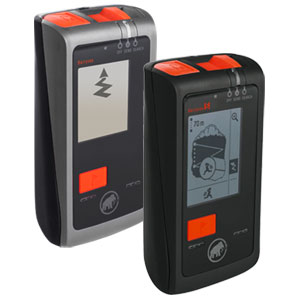Here’s a quick look and a quick test of both the new avalanche transceivers from Mammut. We’ll be doing a full outdoor test with them both soon so keep an eye out for that.
What’s in the box?

- Barryvox / Barryvox S
- BarryHarness
- BarryLeash
- User Manual (full reference guide is available online for the Barryvox S)
- Batteries
Barryvox
The off/send/search switch is on the top of the unit. It’s a 3 stage left/right switch with a mechanical press button lock which prevents it being moved from send without pressing the button. Like on the Pulse/Element the switch protrudes from the side when in search mode allowing it to be easily pressed back to send.

The only other button on the Barryvox is the mark button which is in a nice position to easily press with the thumb. Below this there are two speakers which provide the tones. I would say that the position of the speakers isn’t ideal as my thumb naturally sits on top of the speaker which considerably blocks the sound. In the office this is great as the tones are piercing, not so good in rescue situation.

I did a few small searches in the office so hardly an ideal environment as the electronic interference usually renders transceivers useless. The Barryvox dealt with what must be a cacophony of electromagnetic waves pretty well – it certainly managed to lock onto the correct signal and guide me 3-4 metres to it. I was impressed with how quickly the unit responded to me making some erratic moves.

When you get close it gives you the option to mark (suppress the signal and keep searching) or you can continue to follow the instructions which indicate that you should be moving to a fine search before using a probe.
On electronic interference the Barryvox did notice when I was taking pictures of it with my phone that there was some interference. It displayed a phone symbol in the top right and changed the display to show that the search width was reduced to 20m from the usual 70m. I think this is a great feature.

Barryvox S
The Barryvox S is the ‘full version’ of the Barryvox and has a menu system which allows you to switch various different options on and off as well as add your own use details to the unit. The advanced features can’t be properly tested in an office so I won’t go into them now – we’ll review them when we do a proper test of the unit.
The S has the same construction as the Barryvox but with the addition of 2 buttons on the right side of the unit. These are used to scroll up and down the menu with the mark button being used to confirm the selection.

The Barryvox S has a fully graphical screen enabling much more information to be displayed.�In signal search a diagram with a person moving is shown on screen with a symbol at the bottom of a person running to show that the searcher should be moving as fast as possible at this point.

In the coarse search a directional arrow is displayed and the symbol at the bottom indicates when you should be getting closer to the snow – both transceivers use ‘landing strip’ coarse search method.

In fine search the signal can be marked. If the ‘Pro Search’ feature is enabled signals can also be unmarked and you can scroll between them to select which one you want to receive. The unit clearly displays that you should be probing at 25cm intervals when close to the target!

The Rest
The leash easily larks foots through the base of the transceiver and then has a clip to attach it, via a piece of elastic, to the harness. Don’t ask me why Mammut have thought it necessary to name the leash and the harness ‘Barry’ as well as the transceiver!

The harness is much like the previous harness for the Pulse/Element. The screen goes face in (to protect it) and it has a loop to go over your shoulder and a waist belt, both of which are adjustable.
A link to the manuals and user reference guides can be found in my previous blog post HERE.
You can buy/back order the Barryvox and the Barryvox S on the product pages. If they’re out of stock we’ll keep you updated with delivery times as best we can.

